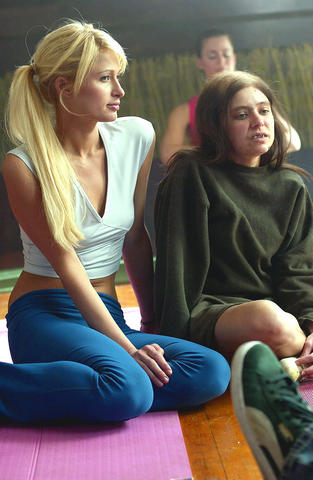The problem with The Hottie and the Nottie is - wait, let me start again. The most crippling of the many problems afflicting The Hottie and the Nottie is the radical disconnect between the title and our perception of the movie's star. I'm not sure on what planet Paris Hilton is considered "hot" - one that involves hazmat suits and tongs, possibly - but it hasn't been Earth for some time.
This may not be fair. For all I know, Hilton is in reality a demure young thing who spends her spare time contemplating String Theory while knitting finger warmers for the lepers of Molokai. Her indelible public persona, however, is that of a - what's the word? Oh, yes: skank. A rich, brainless, clueless skank.
Well, we need our entitled fools. Always have. From Marie Antoinette to the brats on MTV's My Super Sweet 16, they serve a social function by reassuring the plebes that money can't buy intelligence or class. Or, in this case, acting ability. The Hottie and the Nottie - the title makes it sound like a picture book for remedial readers - is a limp low-budget romantic comedy that more or less remakes There's Something About Mary with Hilton in the Cameron Diaz role. Suddenly Diaz is looking like Judi Dench in comparison.

PHOTO: COURTESY OF FOX
Joel David Moore, a likable beanpole usually relegated to nerd character parts, plays the hero, Nate Cooper, who has never gotten over his grade-school crush on little Cristabel Abbott and decides on a whim to drive cross-country and woo her full-time. Cristabel is grown up now and played by Hilton (who also executive produced), and the nonsensical gag is that she's so beauteous men line up on her Santa Monica jogging route with "Marry Me" signs.
Cristabel is still best friends with June Phigg (Christine Lakin), aka "the Nottie." Hairy, clumsy, plagued with sores and green teeth, June's the first line of defense against anyone hoping to score with Cristabel. Nate plots to clean her up and set her up, only to wonder if he's falling for the newly refurbished June himself.
As written by TV scribe Heidi Ferrer and directed by Tom Putnam on a budget lower than Hilton's per diem, The Hottie and the Nottie is more harmless than hateful. You've seen dozens of movies like this on cable in the wee hours, and most of them were made during the Reagan administration. The tone wobbles between gross-out comedy (June's diseased toenail flies off into someone's mouth) and overwritten rom-com earnestness. The lighting is dimmer than the characters.
Since Moore and Lakin are professionals, they're able to give Nate and June's sub-screwball dialogue a bit of snap even when the momentum slows to a crawl. As Nate's fat-slob best friend, The Greg Wilson (that's how he's billed) is supposed to be crassly charming and manages the first half of the equation.
Then there's Hilton. She delivers her lines in an unmodulated near-whisper and keeps her head lowered, gazing up at Nate as if she'd learned Acting Position Number One and then dropped the class. The film poses her in a succession of bikinis, mini-tops, and short shorts, none of which give her the presence necessary to actually hold the screen. Her head seems too small for her body and stuck on at an odd angle. She resembles nothing so much as a tiny blond velociraptor.
That's cruel, I know, but one's mind wanders when a movie's evaporating up there on the screen. More crucially, there's not a whit of mystery to Hilton, as there must be for any proper movie star. How can there be mystery when she's everywhere in our culture, from reality shows to Internet sex videos to tabloid Web sites to perfumes and other personal brand extensions? With all her wealth and meaningless celebritude, Hilton is incapable of doing the one thing most of us desperately wish she would do: Go away.

No one saw it coming. Everyone — including the Chinese Nationalist Party (KMT) — expected at least some of the recall campaigns against 24 of its lawmakers and Hsinchu Mayor Ann Kao (高虹安) to succeed. Underground gamblers reportedly expected between five and eight lawmakers to lose their jobs. All of this analysis made sense, but contained a fatal flaw. The record of the recall campaigns, the collapse of the KMT-led recalls, and polling data all pointed to enthusiastic high turnout in support of the recall campaigns, and that those against the recalls were unenthusiastic and far less likely to vote. That

Behind a car repair business on a nondescript Thai street are the cherished pets of a rising TikTok animal influencer: two lions and a 200-kilogram lion-tiger hybrid called “Big George.” Lion ownership is legal in Thailand, and Tharnuwarht Plengkemratch is an enthusiastic advocate, posting updates on his feline companions to nearly three million followers. “They’re playful and affectionate, just like dogs or cats,” he said from inside their cage complex at his home in the northern city of Chiang Mai. Thailand’s captive lion population has exploded in recent years, with nearly 500 registered in zoos, breeding farms, petting cafes and homes. Experts warn the

A couple of weeks ago the parties aligned with the People’s Republic of China (PRC), the Chinese Nationalist Party (KMT) and the Taiwan People’s Party (TPP), voted in the legislature to eliminate the subsidy that enables Taiwan Power Co (Taipower) to keep up with its burgeoning debt, and instead pay for universal cash handouts worth NT$10,000. The subsidy would have been NT$100 billion, while the cash handout had a budget of NT$235 billion. The bill mandates that the cash payments must be completed by Oct. 31 of this year. The changes were part of the overall NT$545 billion budget approved

The unexpected collapse of the recall campaigns is being viewed through many lenses, most of them skewed and self-absorbed. The international media unsurprisingly focuses on what they perceive as the message that Taiwanese voters were sending in the failure of the mass recall, especially to China, the US and to friendly Western nations. This made some sense prior to early last month. One of the main arguments used by recall campaigners for recalling Chinese Nationalist Party (KMT) lawmakers was that they were too pro-China, and by extension not to be trusted with defending the nation. Also by extension, that argument could be